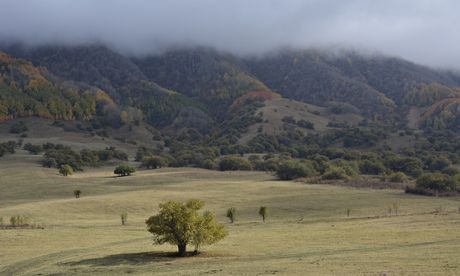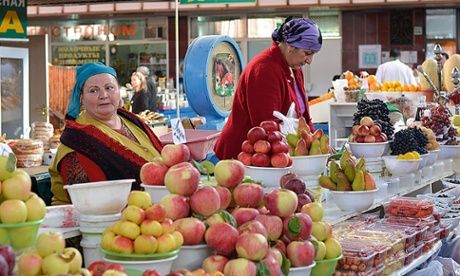 Wheat fields, planted apple orchards and mixed fruit forests in Kazakhstan. Photograph: Ben ReadeApples tumble all over the earth, and I slide with them into a huge old tree, a gentle shower of new fruit fall. I lie back into this soft, dark earth and smell the heady scent of ripening fruit. This Eden is on the side of a mountain in Kazakhstan, where apples originally came from.
Wheat fields, planted apple orchards and mixed fruit forests in Kazakhstan. Photograph: Ben ReadeApples tumble all over the earth, and I slide with them into a huge old tree, a gentle shower of new fruit fall. I lie back into this soft, dark earth and smell the heady scent of ripening fruit. This Eden is on the side of a mountain in Kazakhstan, where apples originally came from.
I’ve dragged the chef Ben Reade along with me. Ben is an intrepid flavour explorer, and he likes an adventure. He will do ludicrous things to taste something new, or in this case something very old. He also has two things I need for this trip: a very good palate, which is important for describing apple flavours, and he’s very tall – at almost 6ft 6in he can reach more apples than me. So here we are, two redheads – one tall, one small – off to find the original apple.
The wild apple grows along the slopes of the Tien Shan mountain range, which borders China and Kazakhstan. The trees are found just above the poplars and below the spruces. Once upon a time these forests ranged so far they stretched right down into the city of Almaty, once the capital of Kazakhstan and which, as any resident will proudly tell you, derives its name from the Kazakh Alma-Ata – the fatherland of the apple.
This is a country in love with its fruit. Apples are sold everywhere from roadsides to shops to train stations. I didn’t see a garden with fewer than three apple trees.
Most apples are domesticated, cultivars of Malus domestica; but look carefully and every now and then you’ll see something smaller, wilder: the native M. sieversii, the original wild apple. It is these we’ve come to find.
M. sierversii is the most likely ancestor of our domestic apple. DNA analysis shows that it closely resembles the apple in your fruit bowl or at the bottom of your garden. These apples vary in size, shape, colour and flavour – the whole spectrum of the domestic apple is here in these small, wily fruits. Some taste of russets, some of apricots, or raspberries, or sweet wines, or heady ciders; the odd one is bitter and tannic.
 The Green Market in Almaty. Photograph: Ben Reade/GuardianI’d like to say that Ben and I found forests as far as the eye could see, but mostly we found relics, slivers – a mountainside covered here, a gorge there. That they used to run everywhere is heartbreaking – the wild apple is under threat. It sits on the International Union for Conservation of Nature’s red list of threatened species, because in Kazakhstan 70% of the population has disappeared over the past 30 years due to agricultural expansion, housing development and overgrazing. That and genetic erosion: the population of wild apples and their DNA has been muddied by surrounding orchards. Apples are promiscuous and bees are plentiful in Kazakhstan (honey sold by the roadside is almost as popular as apples). Many of the trees are wildlings – feral apples if you like, only thinly masking their cultivated parentage.
The Green Market in Almaty. Photograph: Ben Reade/GuardianI’d like to say that Ben and I found forests as far as the eye could see, but mostly we found relics, slivers – a mountainside covered here, a gorge there. That they used to run everywhere is heartbreaking – the wild apple is under threat. It sits on the International Union for Conservation of Nature’s red list of threatened species, because in Kazakhstan 70% of the population has disappeared over the past 30 years due to agricultural expansion, housing development and overgrazing. That and genetic erosion: the population of wild apples and their DNA has been muddied by surrounding orchards. Apples are promiscuous and bees are plentiful in Kazakhstan (honey sold by the roadside is almost as popular as apples). Many of the trees are wildlings – feral apples if you like, only thinly masking their cultivated parentage.
This would matter little, except for the fact that wild apples are such an important gene bank. Cultivated apples are the second most consumed fruit worldwide, with about 70 million tonnes grown every year. Domestic apples are plagued by disease and pests, and it is thought that wild fruits hold many of the answers to these problems. They are also thought to be richer in nutrients. Thus, a shrinking DNA pool is a concern: we may be losing genes we need.
I could claim that I went to Kazakhstan for this reason alone, but the truth is much more selfish: I want to understand what an apple is when unfettered by us. If you want to grow something well, seeing how nature does it is always revealing. It’s not till you wander through these woodlands that you start to understand where the story of the garden of Eden comes from. You can pick out the fruit forest from afar, because by autumn wild apricots burnish a brilliant orange-red; the yellows and greens between them are apples. Then there are pears, maples, large fruited hawthorns, cherry plums, wild pistachios and any number of small, edible berries, from aronias to dewberries. Scrambling up and through the apple trees are hops and wild grapes (an idea ripe for the garden), and between all of these are swaths of seedheads, hinting at how spring and summer must look.
I saw valleys of apples with peonies, clematis, echinops, verbascum, geraniums, violets, ferns, wild mint, hemp, artemisias, delphiniums and far more that I couldn’t identify.
The valleys and woodlands are some of the best gardens I’ve seen. They are magical, full of riches. You can pluck, pick and gather to your heart’s content, and when you tire and are thirsty, a cool brook of clear, clean water rushes close, and above, a golden eagle soars.
The wild apple trees are so different in appearance from our prim, clipped, domesticated ones. Some are small, some tower 60ft or more. They are often multistemmed, and sometimes in huge stands, as they sucker readily. They are a tangle of a tree – some are up to 160 years old. Older trees only fruit every 10 years or so, but when they do, they can cover the floor around them in a thick carpet of fruit. These forests are perfumed with a sweet cider.
The whole forest comes by for apple season. The story of how the apple made it from a remote mountain to your garden has as much to do with birds, boars, deer, bears and horses as it does with nomads. Birds are thought to have carried the seeds of an early apple from China to Kazakhstan, where the Tien Shan brown bear fell in love with them. Bears like big, juicy apples and will hack their way through a tree to get the best fruit, pruning the trees as they go. They poop out the seeds in a perfect germination package. Thus, big, juicy apples do better. Bears don’t roam a great deal, but horses do, and Kazakhstan was one of the first places where they were domesticated. Horses love apples, and distribute the bear-selected apples far and wide.
And somewhere in between, we, too, fell in love with juicy, sweet apples. Nomads took apples as the perfect travel snack – they are rich in vitamin C, easy to carry, and just as nutritious dried. In this way, the apple became one of the first global commodities, travelling down the Silk Road. There are records of Romans, Vikings, ancient Greeks and Persians eating apples, and traces of apple seeds at human settlements as far back as 6500 BC.
I went to find the wild and returned home to the domestic: the last of my apples needed picking. It’s a long journey from those mountains to my garden; genes are being lost all along the way, and the modern apple market is dominated by a few global names. Kazakhstan must protect its important biological heritage: the wild apples must remain wild, and we must protect our heritage, too.
This weekend search out your own apple; there are more than 2,000 varieties. All hold a little wildness in their skin, and keep the gene bank rich. Our future food is held together by diversity, both in wild and cultivated genes; the more the merrier. Travelling halfway around the world for an apple is a pretty niche experience, but going into your garden and eating something delicious doesn’t have to be.
 В Атырау -11
В Атырау -11